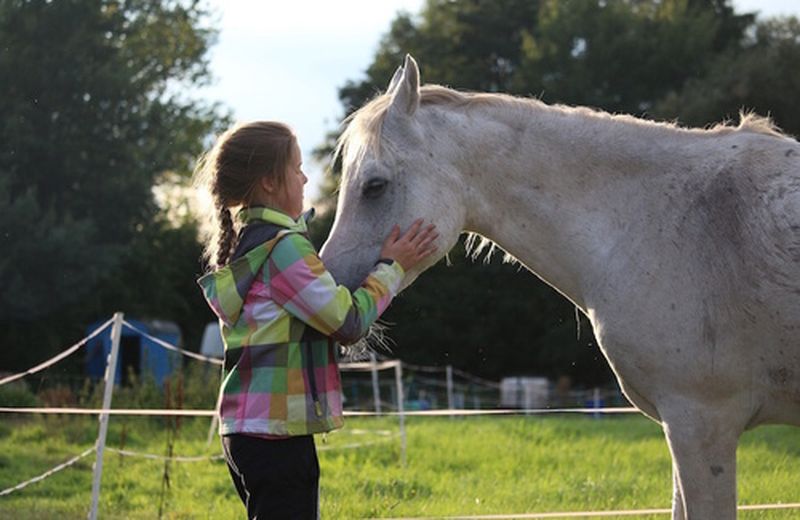The benefits of hippotherapy
Caressing a horse, taking care of it, feeding it and riding it are actions that generate a deep state of psychophysical well-being and make adults and children happy. In this article we talk about the benefits of equestrian rehabilitation and one of its disciplines, hippotherapy.

The millennial relationship that man has established with the horse to facilitate the work in the fields, hunting, travel and war activities, has taken on diversified purposes over time : playful, sporting and therapeutic.
The horse, first perceived as an instrument of subsistence and a symbol of wealth, becomes a companion, friend and therapeutic facilitator .
The beneficial properties of the relationship with this animal have been formally applied in the medical field since the last century, but history and literature are full of references to the benefits of horseback riding.
According to what is reported in the texts on hippotherapy, the first source is Hippocrates , who, as early as the 5th-4th century BC, urged horseback riding to solve insomnia and other problems of the body and mind.
The benefits of the relationship with the horse have been progressively studied by modern medicine up to the creation of a specialized discipline and the training of professionals on the subject.
What does hippotherapy consist of?
The term “hippotherapy” is commonly used to refer to a type of pet therapy that involves all forms of human-horse relationship for therapeutic purposes . But a distinction must be made to understand the complexity of this co-therapy.
In fact, hippotherapy is only one of the disciplines – or phases – that make up the complementary therapeutic activities of equestrian rehabilitation , indicated for people suffering from diseases and disabilities of different types (such as infantile cerebral palsy , autism , Down syndrome , anorexia) .
- Hippotherapy proper is aimed both at people with mild disabilities and pathologies deriving from accidents who will subsequently be able to move on to the other stages of rehabilitation, and at people with more serious pathologies. The therapy takes place both on the ground and on horseback: at first there are activities to approach and care for the animal , to then move on to exercises in the saddle .
- Equestrian re – education is aimed at people with mild to moderate neuromotor disabilities and at people with cognitive behavioral disorders . This phase of therapy, which is more advanced than hippotherapy, consists in an active role of the patient in leading the horse.
- Sports riding for the disabled : in this phase, riding exercises are carried out which provide a good degree of autonomy for the disabled and may consist of demonstrative and competitive activities.
A horse as a friend: what can you learn from horses?
The benefits of hippotherapy
Hippotherapy and all the equestrian rehabilitation activities are not designed to heal , but rather to improve the quality of life of patients through a wide range of benefits that the human-horse relationship is able to offer .
The benefits of hippotherapy depend largely on the physical and behavioral characteristics of the horse , but also on the demedicalized context in which the activities are carried out.
These – although they are followed by a specialized team made up of neurologists, psychologists and therapists – take place in a non-hospitalized and pleasantly stimulating environment , thus facilitating the patient’s predisposition and the effectiveness of the activities.
Let’s see what are the benefits that hippotherapy offers with respect to various spheres that form the person.
- Cognitive-sensory benefits: the rehabilitation exercises on horseback and the context of the riding school work on cognitive stimulation, favoring the improvement of the patient ‘s ability to concentrate , logic and memory . Even the senses are intensely stimulated by every activity carried out in contact with the horse, so they are particularly suitable for people suffering from sensory deficits.
- Motor benefits: from a neuromotor point of view, the exercises in the saddle and the movement of the horse are valid stimulants. It works on balance , muscle tone , coordination and motor awareness of the patient .
- Psychological-behavioral benefits: the main psychological benefit is the increase in self -esteem generated by the small responsibilities assigned to the patient. Horse care activities and handling rules also help the patient to assimilate positive behavioral patterns that can help reduce aggression and increase his interpersonal skills .
- Socio-affective benefits : the relationship established with the horse is able to generate a reassuring and beneficial emotional bond over time. The horse, in fact, becomes a channel of mediation , thus favoring the patient’s openness to the outside world and stimulating his socialization skills.
































+ There are no comments
Add yours